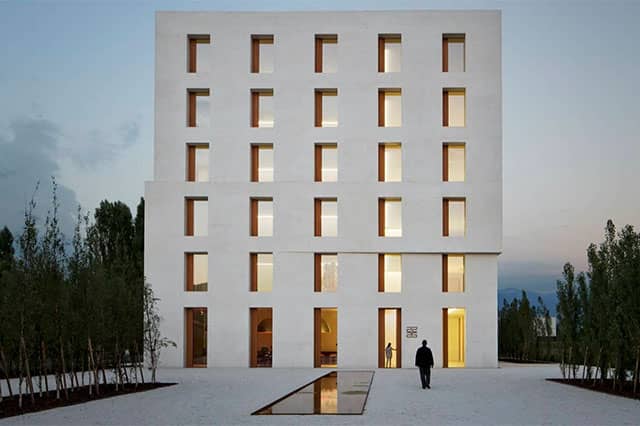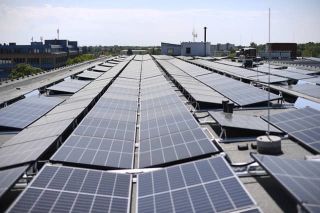
www.buildingsandcities.org/insights/commentaries/rethinking-ieq-standards.html
Rethinking IEQ Standards for a Warming Post-COVID World

Are standards promoting air conditioning and marginalising natural ventilation?
Current codes are making buildings more reliant on air-conditioning at the expense of natural ventilation and other cooling solutions. Adam Rysanek (University of British Columbia) explains why this should be countered. Revolutionising codes in a manner that widens the responsibility of architects and engineers to deliver IEQ is urgently needed in advance of future public health crises and the climate emergency.
Over the last several years, my research group and colleagues elsewhere have examined climate resiliency and alternatives to air-conditioning in the built environment (Teitelbaum et al. 2020, Aviv et al. 2021). This work has contributed to a growing body of studies on these subjects, exemplified not in the least in the Buildings & Cities special issue: Alternatives to Air Conditioning: Policies, Design, Technologies, Behaviours. Coleman & Robinson (2018) examined one of British Columbia's hallmark naturally-ventilated high performance buildings (the Centre for Interactive Research on Sustainability at the University of British Columbia in Vancouver). Rysanek et al. (2020) compared this building's performance data against anticipated future climate change scenarios. We found that several of its occupied office spaces will cease to comply with the adaptive comfort model within the next decade. Forecasted rises in daytime indoor temperatures due to more frequent and extreme heat waves and less effective diurnal purging at night suggest that some cooling intervention will be needed. As others have observed, there can be limits to natural ventilation.
Natural ventilation as an essential feature of the healthy building
Accepting these limits, however, must not trivialise the use of natural ventilation in the future of building design, even in a future concerned with respiratory illnesses, and especially in a future concerned with climate change. How our institutions responded to concerns about indoor environmental quality (IEQ) over the last two years of the COVID-19 pandemic serves as a lesson for the challenges ahead with the climate emergency.
Research has established that people prefer indoor environments that have a connection to nature, e.g. indoor planting, a view of the sky, or direct fresh air (e.g. Olgyay 1963, Ulrich 1984, Ryan et al. 2014, Hähn et al. 2021). Evidence shows that these environmental design conditions can measurably improve our health and well-being, both physical and mental. These conditions can mitigate long-term health costs, even premature deaths (Wargocki et al. 2002, Dutton et al. 2013, Allen et al. 2015, Coutts & Horner 2015). Pertinent to COVID-19, prior studies have shown how natural ventilation can be a vital tool for managing infection control in buildings (Atkinson et al. 2009, Short et al. 2014). This knowledge has been at the core of the renaissance of bioclimatic design in the field of architecture.
It can nevertheless be challenging to implement these bioclimatic design measures in practice as well as identify the specific performance criteria that building designers should meet (Altomonte et al. 2020). In respect to natural ventilation, if outdoor air quality is poor, if the wind is not blowing, if it is just too hot, then it may be better to keep windows closed. However, this caution must not be taken too far as it can create a new suite of future IEQ problems. Unfortunately, this is exactly what some regions of the world may have done during this pandemic.
The security blanket of mechanical ventilation during COVID-19
ASHRAE's (2021a) COVID-19 technical guidelines for all residential dwellings appears to state that the operation of windows for ventilation is an 'acceptable alternative' to mechanical ventilation only in homes that do not have any mechanical ventilation system installed. ASHRAE's (2020) guidance directed at owners / managers of multi-family dwellings goes further by instructing residents to open windows as little as possible if their buildings are equipped with mechanical ventilation. ASHRAE's (2021b) FAQ directed at homeowners themselves informs them that it is not necessarily advised they open their windows, even if they do not have a mechanical ventilation system, with several reasons given to keep windows closed. One of these reasons is thermal discomfort, with ASHRAE suggesting that it is better to avoid discomfort by leaving windows closed and installing portable air purifiers instead.
In contrast to ASHRAE, CIBSE (2021) provided a thorough recommendation on the use of natural ventilation via operable windows in buildings and went as far as recommending that natural ventilation should be taken advantage of year-round, even in winter. REHVA (2021) had a similar stance, with the 4th of its top-15 most practical measures for building operators during the pandemic being: 'Open windows regularly (even in mechanically ventilated buildings)'.
How did these differences in position occur? Although CIBSE, ASHRAE, and REHVA cover different geographical regions with unique histories, architectural contexts and climates, one is left to question how ASHRAE's COVID-19 guidelines came to marginalise natural ventilation so thoroughly. Whether intentional or not, ASHRAE's guidelines seem to create a binary fallacy: that one should choose between mechanical ventilation and natural ventilation (not engage with both), and that mechanical ventilation is the preferred option.
Even if these guidelines were backed by our latest thinking with respect to COVID-19 and building physics, the implications of the guidelines are worrying. Today's young adults are likely to inhabit a greater share of smaller, multi-family dwellings than their parents, and they may inhabit them for longer stretches of time (i.e., work-from-home). Most of these homes are destined to have mechanical ventilation systems installed (Martin et al. 2020). ASHRAE's guidelines imply that these inhabitants will be in a position of good health by relying on 100% mechanically-ventilated air-conditioning with effectively no need for operable windows. In 2022, it is absurd that society would return to the architecture of the 1950s and the 'internationalist' style as an example of 'good thinking' with respect to holistic IEQ and energy efficiency. In the age of climate emergency and the rising cost of living, it is madness to create new dependencies on HVAC systems that represent significant energy demands and GHG emissions.
The installation of mechanical ventilation must not preclude developers, architects, engineers, and building occupants from configuring buildings to rely on natural ventilation and passive cooling measures as much as possible.
Rethinking standards, codes, and practices
Just before COVID, building designers were moving gradually towards a new paradigm of low-carbon, high-performance, mixed-mode buildings. These were buildings that better blended passive environmental systems, e.g. natural ventilation and ceiling fans, with smaller-scale HVAC systems. Some went even further. Haus 2226 is an office building in Lustenau, Austria, a town with more heating degree-days than New York City. The building has no mechanical system whatsoever: heating, cooling, or ventilation. It relies only on solar and internal heat gains, thermal mass, and natural ventilation to maintain a year-round indoor temperature between 22 and 26 oC. The building uses motorised dampers that allow controlled leakage throughout the building's windows as determined by indoor CO2 concentrations. For years, its design firm, Baumschlager Eberle, argued that the building was successful thermally and provided a good standard of indoor air quality (Eberle & Aicher 2016). Several new buildings in Austria and Switzerland are implementing the '2226' approach including a large multi-family dwelling now under construction - see https://www.2226.eu/en/implementation/.
The question that civil society (especially in North America) faces is whether its regime of building codes, standards, institutional guidelines and real estate norms are systemically dis-incentivising architects and clients from attempting these projects, delaying the emergence and - ultimately - the normalisation of these seemingly radical building ideas.
The urgency of climate change demands a re-examination of institutional frameworks such as building codes. The trades of architecture and engineering must share formal responsibility for IEQ, public health and climate mitigation / adaptation, including how occupants receive fresh air indoors. This 'sharing' should be reflected in building codes with a clear, performance-based mandate that engages architects thoroughly and places as much responsibility on architects to deliver IEQ as it does engineers.
How could this be done? The promotion of best practice across jurisdictions is needed and would be greatly assisted by deconstructing barriers or introducing incentives that accelerate the cross-pollination and improvement of existing standards. CIBSE's environmental design guides and technical memoranda, particularly CIBSE TM 40 (2019) contain progressive yet science-informed recommendations for natural ventilation and other building environmental systems that may be applicable globally and to a larger cross-section of AEC professionals than primarily mechanical engineers. The WELL Building Standard (IWBI 2020) is increasingly well-regarded by designers and developers who have begun to recognise whole-building IEQ also contributes to a building's financial valuation. Some of the tenets of the WELL standard could very well serve as the basis of a healthy building code.
If we neither establish new regulatory criteria on whole-building IEQ, nor deconstruct overly-specified existing criteria on the primacy of thermal comfort, then little may change in the building sector and reliance will increase on air-conditioning and mechanical systems. If suitable alternatives to air conditioning are not used, this will exacerbate the climate emergency and contribute to future health problems.
References
Allen, J.G., MacNaughton, P., Laurent, J.G.C., Flanigan, S.S., Eitland, E.S. & Spengler, J.D. (2015). Green buildings and health.Current environmental health reports,2(3), 250-258.
Altomonte, S., Allen, J., Bluyssen, P.M., Brager, G., Heschong, L., Loder, A., Schiavon, S., Veitch, J.A., Wang, L. & Wargocki, P. (2020). Ten questions concerning well-being in the built environment. Building and Environment, 180, 106949. https://doi.org/10.1016/j.buildenv.2020.106949
ASHRAE. (2020). COVID-19 Guidance for Multifamily Building Owners/Managers. https://www.ashrae.org/file%20library/technical%20resources/covid-19/covid-19-guidance-for-multifamily-building-owners_managers.pdf
ASHRAE. (2021a). Residential COVID-19 Guidance. https://www.ashrae.org/file%20library/technical%20resources/covid-19/ashrae-covid-19-residential-guidance.pdf
ASHRAE. (2021b). Residences FAQ. https://www.ashrae.org/technical-resources/residences-faq
Atkinson, J., Chartier, Y., Pessoa-Silva, C.L., Jensen, P., Li, Y. & Seto, W.H. (2009). Natural Ventilation for Infection Control in Health-Care Settings. Geneva: World Health Organization.
Aviv, D., Chen, K.W., Teitelbaum, E., Sheppard, D., Pantelic, J., Rysanek, A. & Meggers, F. (2021). A fresh (air) look at ventilation for COVID-19: Estimating the global energy savings potential of coupling natural ventilation with novel radiant cooling strategies. Applied Energy, 292, 116848.
CIBSE. (2019). TM40: Health and wellbeing in building services. https://www.cibse.org/Knowledge/CIBSE-TM/TM40-2019-Health-Issues-and-Wellbeing-in-Building-Services#Exec%20summary
CIBSE. (2021). COVID-19: Ventilation. Version 5. https://www.cibse.org/emerging-from-lockdown#1
Coleman, S. & Robinson, J.B. (2018). Introducing the qualitative performance gap: stories about a sustainable building. Building Research & Information, 46(5), 485-500.
Coutts, C. J. & Horner, M.W. (2015). Nature and death: an individual level analysis of the relationship between biophilic environments and premature mortality in Florida. Spatial Analysis in Health Geography, 295.
Dutton, S.M., Banks, D., Brunswick, S.L. & Fisk, W.J. (2013). Health and economic implications of natural ventilation in California offices. Building and Environment, 67, 34-45.
Eberle, D. & Aicher, F. (eds.). (2016). be 2226 Die Temperatur der Architektur: eines energieoptimierten Hauses / The Temperature of Architecture: Portrait of an Energy-Optimized House. Birkhäuser.
Hähn, N., Essah, E. & Blanusa, T. (2021). Biophilic design and office planting: a case study of effects on perceived health, well-being and performance metrics in the workplace. Intelligent Buildings International, 13(4), 241-260.
IWBI. (2021). The WELL Building Standard v2. International WELL Building Institute. https://dev-wellv2.wellcertified.com/
Martin, E., Khan, T., Chasar, D., Sonne, J., Rosenberg, S., Antonopoulos, C. ... & Lubliner, M. (2020). Characterization of mechanical ventilation systems in new US homes: what types of systems are out there and are they functioning as intended. 2020 Summer Study on Energy Efficiency in Buildings.
Olgyay, V. (1963). Design with Climate: Bioclimatic Approach to Architectural Regionalism. Princeton University Press.
REHVA. (2021). COVID-19 Guidance. Version 4.1. https://www.rehva.eu/activities/covid-19-guidance/rehva-covid-19-guidance
Ryan, C.O., Browning, W.D., Clancy, J.O., Andrews, S.L. & Kallianpurkar, N.B. (2014). Biophilic design patterns: emerging nature-based parameters for health and well-being in the built environment. International Journal of Architectural Research, 8(2), 62.
Rysanek, A., Nuttall, R. & McCarty, J. (2021). Forecasting the impact of climate change on thermal comfort using a weighted ensemble of supervised learning models. Building and Environment,190, 107522.
Short, C.A., Noakes, C.J., Gilkeson, C.A. & Fair, A. (2014). Functional recovery of a resilient hospital type. Building Research & Information, 42(6), 657-684.
Teitelbaum, E., Chen, K.W., Aviv, D., Bradford, K., Ruefenacht, L., Sheppard, D. & Rysanek, A. (2020). Membrane-assisted radiant cooling for expanding thermal comfort zones globally without air conditioning. Proceedings of the National Academy of Sciences, 117(35), 21162-21169.
Ulrich, R.S. (1984). View through a window may influence recovery from surgery. Science, 224(4647), 420-1. https://doi.org/10.1126/science.6143402
Wargocki, P., Sundell, J., Bischof, W., Brundrett, G., Fanger, P.O., Gyntelberg, F. ... & Wouters, P. (2002). Ventilation and health in non-industrial indoor environments: report from a European multidisciplinary scientific consensus meeting (EUROVEN). Indoor Air, 12(2), 113-128.
Latest Peer-Reviewed Journal Content
A framework for 1.5°C-aligned GHG budgets in architecture
G Betti, I Spaar, D Bachmann, A Jerosch-Herold, E Kühner, R Yang, K Avhad & S Sinning
Net zero retrofit of the building stock [editorial]
D Godoy-Shimizu & P Steadman
Co-learning in living labs: nurturing civic agency and resilience
A Belfield
The importance of multi-roles and code-switching in living labs
H Noller & A Tarik
Researchers’ shifting roles in living labs for knowledge co-production
C-C Dobre & G Faldi
Increasing civic resilience in urban living labs: city authorities’ roles
E Alatalo, M Laine & M Kyrönviita
Co-curation as civic practice in community engagement
Z Li, M Sunikka-Blank, R Purohit & F Samuel
Preserving buildings: emission reductions from circular economy strategies in Austria
N Alaux, V Kulmer, J Vogel & A Passer
Urban living labs: relationality between institutions and local circularity
P Palo, M Adelfio, J Lundin & E Brandão
Living labs: epistemic modelling, temporariness and land value
J Clossick, T Khonsari & U Steven
Co-creating interventions to prevent mosquito-borne disease transmission in hospitals
O Sloan Wood, E Lupenza, D M Agnello, J B Knudsen, M Msellem, K L Schiøler & F Saleh
Circularity at the neighbourhood scale: co-creative living lab lessons
J Honsa, A Versele, T Van de Kerckhove & C Piccardo
Positive energy districts and energy communities: how living labs create value
E Malakhatka, O Shafqat, A Sandoff & L Thuvander
Built environment governance and professionalism: the end of laissez-faire (again)
S Foxell
Co-creating justice in housing energy transitions through energy living labs
D Ricci, C Leiwakabessy, S van Wieringen, P de Koning & T Konstantinou
HVAC characterisation of existing Canadian buildings for decarbonisation retrofit identification
J Adebisi & J J McArthur
Simulation and the building performance gap [editorial]
M Donn
Developing criteria for effective building-sector commitments in nationally determined contributions
P Graham, K McFarlane & M Taheri
Reimagining circularity: actions for optimising the use of existing buildings
R Lundgren, R Kyrö, S Toivonen & L Tähtinen
Effective interdisciplinary stakeholder engagement in net zero building design
S Vakeva-Baird, F Tahmasebi, JJ Williams & D Mumovic
Metrics for building component disassembly potential: a practical framework
H Järvelä, A Lehto, T Pirilä & M Kuittinen
The unfitness of dwellings: why spatial and conceptual boundaries matter
E Nisonen, D Milián Bernal & S Pelsmakers
Environmental variables and air quality: implications for planning and public health
H Itzhak-Ben-Shalom, T Saroglou, V Multanen, A Vanunu, A Karnieli, D Katoshevski, N Davidovitch & I A Meir
Exploring diverse drivers behind hybrid heating solutions
S Kilpeläinen, S Pelsmakers, R Castaño-Rosa & M-S Miettinen
Urban rooms and the expanded ecology of urban living labs
E Akbil & C Butterworth
Living with extreme heat: perceptions and experiences
L King & C Demski
A systemic decision-making model for energy retrofits
C Schünemann, M Dshemuchadse & S Scherbaum
Modelling site-specific outdoor temperature for buildings in urban environments
K Cebrat, J Narożny, M Baborska-Narożny & M Smektała
Understanding shading through home-use experience, measurement and modelling
M Baborska-Narożny, K Bandurski, & M Grudzińska
Building performance simulation for sensemaking in architectural pedagogy
M Bohm
Beyond the building: governance challenges in social housing retrofit
H Charles
Heat stress in social housing districts: tree cover–built form interaction
C Lopez-Ordoñez, E Garcia-Nevado, H Coch & M Morganti
An observational analysis of shade-related pedestrian activity
M Levenson, D Pearlmutter & O Aleksandrowicz
Learning to sail a building: a people-first approach to retrofit
B Bordass, R Pender, K Steele & A Graham
Market transformations: gas conversion as a blueprint for net zero retrofit
A Gillich
Resistance against zero-emission neighbourhood infrastructuring: key lessons from Norway
T Berker & R Woods
Megatrends and weak signals shaping future real estate
S Toivonen
A strategic niche management framework to scale deep energy retrofits
T H King & M Jemtrud
Generative AI: reconfiguring supervision and doctoral research
P Boyd & D Harding
Exploring interactions between shading and view using visual difference prediction
S Wasilewski & M Andersen
How urban green infrastructure contributes to carbon neutrality [briefing note]
R Hautamäki, L Kulmala, M Ariluoma & L Järvi
Implementing and operating net zero buildings in South Africa
R Terblanche, C May & J Steward
Quantifying inter-dwelling air exchanges during fan pressurisation tests
D Glew, F Thomas, D Miles-Shenton & J Parker
Western Asian and Northern African residential building stocks: archetype analysis
S Akin, A Eghbali, C Nwagwu & E Hertwich
Join Our Community

The most important part of any journal is our people – readers, authors, reviewers, editorial board members and editors. You are cordially invited to join our community by joining our mailing list. We send out occasional emails about the journal – calls for papers, special issues, events and more.
We will not share your email with third parties. Read more



Latest Commentaries
COP30 Report
Matti Kuittinen (Aalto University) reflects on his experience of attending the 2025 UN Conference of the Parties in Belém, Brazil. The roadmaps and commitments failed to deliver the objectives of the 2025 Paris Agreement. However, 2 countries - Japan and Senegal - announced they are creating roadmaps to decarbonise their buildings. An international group of government ministers put housing on the agenda - specifying the need for reduced carbon and energy use along with affordability, quality and climate resilience.
Building-Related Research: New Context, New Challenges
Raymond J. Cole (University of British Columbia) reflects on the key challenges raised in the 34 commissioned essays for Buildings & Cities 5th anniversary. Not only are key research issues identified, but the consequences of changing contexts for conducting research and tailoring its influence on society are highlighted as key areas of action.